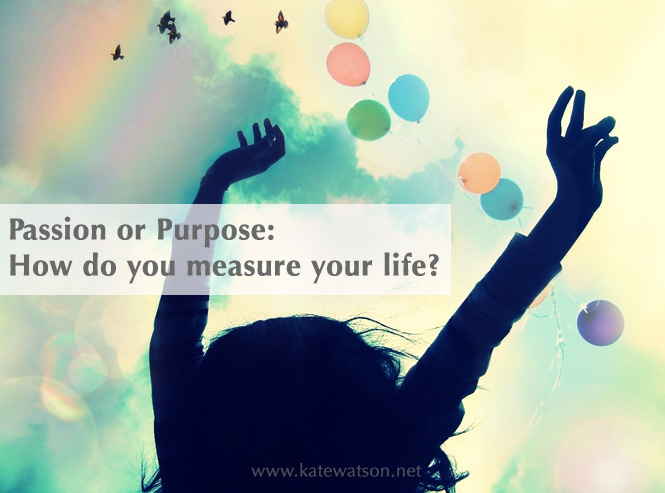
Passion and purpose have been coming to my attention a lot lately. In July, I asked my Facebook friends, “What’s your passion?” Secretly I was hoping to find more folks for my Passion Project series, but what I got was a variety of responses, including:
- Make-up
- Facilitating awakenings
- Making the sale
- Dance
- Leading a healthy lifestyle
- Loving Jesus
- Travel
- Writing
- Photography
- Yoga
- Puppies
Many people claimed multiple passions. Some said their passion was “helping people” do things like reach their fitness goals or create beautiful websites. Others said they were still figuring it out.
Because I’d gotten such a strong initial response, I asked another question: Would your answer change if I’d asked “What is your purpose?” For most people, it would have.
Cassandra Rae of Petals of Change replied, “You know, Kate, I might not have even answered the question if you’d used purpose. There is a pressure that comes with purpose whereas there is a freedom around passion.” Thanks, Cassandra, that’s how I’ve always felt about the terms too.
Career coach Ariane Hunter, who I call a purpose expert, added, “I think purpose takes on both the light and darkness of the human experience. Purpose is the being more than the doing. To me, passion is what you do, purpose is what/who you are being. It’s like an unfolding that reveals who you truly are.”
Laura Simms of Create as Folk shared still another viewpoint in a recent blog post, that people don’t have a purpose! She explains, “Objects have a purpose. A hammer is for putting nails in. A couch is for sitting. You are a person. Can we agree you’re more complex than a hammer? Than a couch? When you put the pressure on yourself to define your Purpose, you give yourself an impossible task. So don’t worry about finding your Purpose.”
As you can see, there seem to be a lot of disparate opinions about passion and purpose, which led me to contemplate the definition of each. Merriam-Webster says:
Passion is a strong feeling of enthusiasm or excitement for something or about doing something.
Purpose is the aim or goal of a person: what a person is trying to do, become, etc.
Reading the definitions of passion and purpose helped clarify a lot for me. You, too?
Suddenly purpose doesn’t seem so weighty and pressure-filled. In fact, it has become downright direct:
My purpose is to be the best version of myself I can be which, as Ariane pointed out on her blog, is “constantly unfolding and revealing new layers of depth.”
I’ve said before that I believe we all do the best we can with our current understanding of the world. Therefore, it could be argued that we are all living our purpose each and every day, in everything we do, as Ariane has suggested. If we think of purpose that way, it becomes something we don’t have to go looking for at all; it is fundamental to our being.
Since purpose is taken care of, what of passion? I say your passions are the place to dedicate your time and, yes, I believe you can have several. I certainly do! When we seek out and live our passions, I believe we will find the true meaning of our lives.
And so I’ll end where we started: What are your passions?
If you’re still figuring it all out, artist and type designer Sean Wes has some tips.
Cheers,

Photo Credit: Camdiluv ♥ via Compfight cc
Did I tell you I hung my first watercolor show? Yep, I totally did. #11 on my 40 before 40 List and it’s done. Well, actually, the show is still up and I invite you to go check it out if you’re in the area.
Throughout the month of August, two of my paintings will hang at Los Altos Library in the the group watercolor show, “Guy Magallanes and Selected Students.”
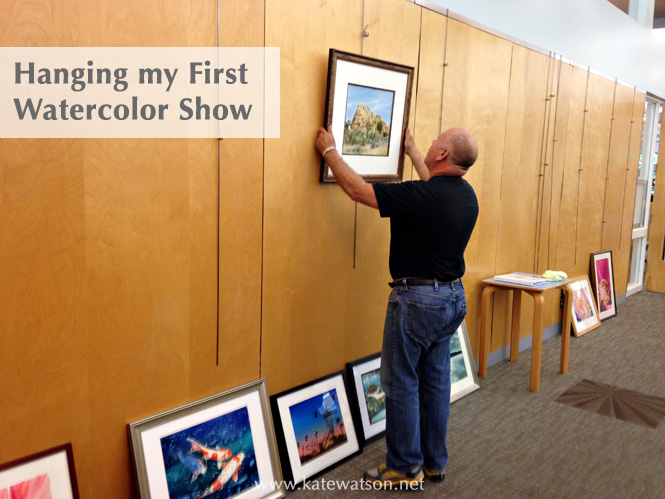 Guy hangs the first painting When Guy asked me if I wanted to participate, I made an ugly face and said something like, “Really? Why?” I wasn’t sure I wanted to ruin the pure joy of painting by sharing my work with a judgmental public.
I am truly a beginner, only having been painting since 2011 and with Guy since July 2012. I still see marked improvement on each new painting, which tells you how far I still have to go. I’ve also been very careful to keep painting personal, to avoid commercializing it in any way lest it go the way of photography. After a few week’s consideration, I decided to give it a go—and I’m glad I did.
To prepare for the show, I had to have my paintings matted and framed. I took them to Photograph & Frame in Palo Alto for custom mats. I asked for the mat to be cut to fit in a standard frame, in this case 16×20. Then I took advantage of the Aaron Brothers 1-cent sale to buy two frames for the price of one, and asked the staff there to string the back wire for me (only $5 per frame). I got both images matted and framed for less than $125. Pretty good deal, I thought.
Turns out that, while I was running around town, one of my peers took her painting to Michael’s for their Custom Frame Express service and got hers done for even less. Looks like there are a lot of great options for affordable framing these days. Cool, right?!
In addition to preparing the paintings for hanging, we had to write artist’s statements and bios for the exhibition guide. I’ll share more about that another time.
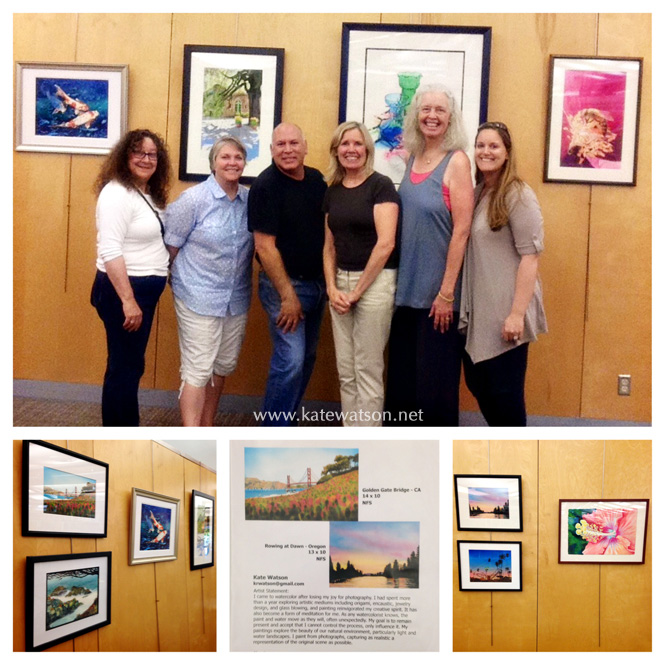 Top, from left to right: Carmel Adams, Susan Jochheim, Guy Magallanes, Cheri Gustafson, Bonnie Gilkis and me. Bottom left: Paintings by me (top) and Nga Bui (bottom). Center: Artist statement & bio in exhibition book. Right: Paintings by me (top), Margaret Inokuma (bottom), and Virginia Weiss (right) All of the show participants gathered at Los Altos Library the afternoon of August 1st. The exhibition area’s hanging system consists of a top, wall-mounted rail and flexible metal rods that can be added, relocated or removed. Each rod has one or more hooks that move freely along the rod to hold artwork. It looks similar to this.
We began by lining the paintings up along the floor. While some of the other newbies hung out and watched, I had a lot of opinions about what looked nice together and offered them up. Did you expect anything less? 😉 I kept being drawn to placing paintings with similar color themes and aspect ratios together and that’s how our big wall came together. Here it is:
 Paintings from left to right credited to Cheri Gustafson, Guy Magallanes, Bonnie Gilkis, yours truly (top), and Margaret Inokuma (bottom) Any questions about hanging an art show? Let me know in the comments.
If you’d like to see the show, please visit Los Altos Library at 13 S San Antonio Road before August 30th.
Cheers,


Today is World Elephant Day. Because elephants are my favorite animals, today I’m asking you to join me in learning more about significant threats to these majestic creatures and in supporting preservation efforts.
 About Elephants About Elephants
There are two species of elephant, African and Asian. Although similar in appearance, they are too dissimilar biologically to interbreed. Both species are severely threatened, with Asian elephants considered endangered and African elephants threatened.
Habitat loss due to climate change and deforestation, human-elephant conflict, and poaching are all contributing to a sharp decline in the elephant population.
I may have mentioned poaching last but it has had a tremendous impact—poachers slaughtered more than 20,000 African elephants in 2013 according to the Secretariat of the Convention on International Trade in Endangered Species of Wild Fauna and Flora (CITES), and some sources estimate the total at more than 35,000 elephant deaths.
Why World Elephant Day?
World Elephant Day was launched in 2012 “to bring attention to the urgent plight of Asian and African elephants.” As the founders state, “The elephant is loved, revered and respected by people and cultures around the world, yet we balance on the brink of seeing the last of this magnificent creature.”
In 2008, conservation researchers warned that African elephants may be extinct by 2020. Recent reports suggest nothing has changed to improve that estimate; wild African elephants could be a memory just six years from now—for all of the reasons listed above but, most dire, poaching.
National Geographic reports, “In January 2012 a hundred raiders on horseback charged out of Chad into Cameroon’s Bouba Ndjidah National Park, slaughtering hundreds of elephants—entire families—in one of the worst concentrated killings since a global ivory trade ban was adopted in 1989… Elephant poaching levels are currently at their worst in a decade, and seizures of illegal ivory are at their highest level in years.”
The situation is now so dire that I believe it is up to every one of us to become informed about this situation. And sadly many people don’t seem to be listening.
To begin your education, watch this video produced by the David Sheldrick Wildlife Trust in Kenya:
You may now be asking, “Why is there so much poaching?” Because there is a tremendous and growing desire for jewelry, carvings and trinkets made from ivory, aka elephant tusks, in Asian countries, including China, Thailand, and the Philippines. The United States is not as far removed from illegal ivory trafficking as you might assume, however, as Adam Welz reports for Yale Environment 360.
 A customer, left, shops for ivory bracelets at an ivory shop in Nakhon Sawan province, 130 miles north of Bangkok, Thailand, April 17, 2002. There is a lot of misinformation about ivory. IFAW reports that “many ivory buyers are unaware of the cruelty and conservation impacts of poaching elephants.” And poachers pray on consumer ignorance, perpetuating myths such as:
- Ivory comes from elephant teeth, which fall out naturally and are replaced by new growth.
- Ivory is only taken from elephants who have been killed by African families for meat.
- Ivory is procured by removing only the ends of the tusks after elephants are tranquilized.
None of this is true. Poachers get most ivory by killing elephants and hacking off their tusks at the skull.
Take a few moments to think about the heinous act of killing an elephant purely for its tusks, hacking them out of its skull, and leaving the rotting corpse behind. Both male and female African elephants have tusks, unlike Asian elephants, and so this crime is harming entire herds of elephants and decimating the species at large.
 A rotting elephant carcass in Hwange National Park, Zimbabwe, after poachers poisoned waterholes with cyanide, Sept. 29, 2013.  In this photo, taken May 21, 2014, Park rangers stand next to the remains of elephants that were killed by poachers in the Garamba National Park, situated in Democratic Republic of Congo. Jason Bell of IFAW wrote today: “We are fast approaching the tipping point where there won’t be enough time left to make fundamental behaviour [sic] change.” So, let’s join together to do something about this now, before it’s too late!
How You Can Help
As a friend of a friend, entrepreneur Bud Wilson, recently shared on Facebook:
“It is very simple. Humans must learn that we are all part of an extremely beautiful and delicate web of interdependent life. Reverence for all that is human and non-human is the core principle that is missing.”
How can you help?
1. Learn more about the crisis. Here are a few resources to get started:
2. Pledge to save elephants with IFAW and/or sign the iWorry petition to end the ivory trade.
3. Offer your support to organizations working on the front lines:
4. Share the truth with others.
Thank you, for your children and your children’s children,

Featured Image Photo Credit: digitalART2 via Compfight cc
Last week, I shared my pillars of happiness, 10 (ok, 11!) reminders that help me to lead a happy, healthy life. Today I’d like to help you develop yours.
First, let’s talk about what I mean by happiness. For me, true happiness is about being satisfied with your life. It’s not about a frenzied ecstasy or intensity of feeling, which is fleeting and unsustainable. Rather the pillars were developed to help create a long-term sense of well-being and they provide reminders to help you do just that.
So, now that you better understand their purpose, let’s talk about how you can develop your own. On a holistic level, determining what makes you happy is about being present to how you’re feeling. When you’re feeling good, take note of what’s going on in your life? Where are you and what are you doing when you’re feeling content, happy, settled? What lessons can you take from that feel-good experience?
If you’re not feeling so hot, however, it may be harder to identify what would help. You could look back to the last time you did feel good, but you can also consider certain elements of necessity for all humans. Start with the basics:
- Have you been taking care of your body? Have you been eating well, drinking sufficient water, and getting adequate sleep?
- Do you have any immediate health needs? Allergy symptoms? Pain? What can you do about that?
- Do you feel safe? Are you secure in your home environment and employment? If you feel unsafe, consider what would help make you feel more secure: a job change, asking for additional support from your friends and family, or would changing your outlook improve your feelings about your situation?
Yes, it’s really that simple. If you have a tendency to forget any of these critical human needs, they are great starts to your pillars. For example, mine include taking a multivitamin or iron supplement because, when I’m feeling ok, I tend to stop taking my iron supplement and, when I’m feeling run down, the list provides a little jolt of aha! on which I can take positive action. If you find that you’re physically fine but your attitude needs improvement, consider creating a gratitude practice.
After your basic needs are being met, it will be easier to discover other factors that bring you joy. For example, do you feel better:
- After sitting in the sun?
- Going for a walk?
- Listening to music?
- Connecting with a friend?
- Doing something productive?
- Cleaning?
- Creating or thinking creatively?
- Repeating or writing an affirmation?
- Praying or meditating?
- Setting aside some alone time?
- Taking 20 minutes to read for pleasure?
- Practicing yoga or going for a run?
As I write this, Jack Johnson’s “Banana Pancakes” is playing. I don’t eat banana pancakes—not really a banana fan—but I love the song! And it’s perfect to wrap this post. After all, the song is about taking pleasure in the moment and, as Jack sings, it’s meant to “keep ya from doing what you’re supposed to…”
Being present to how you’re feeling and doing what you want to versus what you believe you’re supposed to is the bottom line when it comes to developing and living your pillars of happiness.
Enjoy—and please let me know how you do!
Cheers,

Special thanks to my friend Cassandra for inspiring me to write this post and the one before it!
A while back I was talking with a friend about my pillars of happiness: 10 reminders that help me lead a happier, healthier life. She told me that it was a new way of thinking for her, the idea that happiness could be cultivated and made intentional.
For me, learning to be content with my life stemmed from acknowledging my feelings and honoring my needs, my natural tendencies and rhythms. Here are my pillars:
- Release the negative
- Express gratitude
- Eat healthily
- Take a multivitamin or iron supplement
- Exercise
- Get outdoors
- Create
- Check for tiredness
- Trust in my value
- Be productive
- Connect
These pillars have been developed over many years and are, first and foremost, reminders. When I’m feeling a bit off, a bit unhappy, I review the list: Have I been taking a multivitamin or iron supplement? Do I need a nap? Have I gotten exercise or been outdoors lately?
The pillars are also open to continual adjustment and improvement. For example, I just added “connect,” acknowledging that I have a tendency to hermit but that getting out of the house and reaching out to others often feels better.
Many of my pillars of happiness are pretty self-explanatory but, for the few that aren’t, I’ll add some clarification:
Releasing the Negative
As I’ve mentioned, I had a fairly negative mindset growing up and so, when I’m in a bad mood or not feeling so hot, my negative thoughts could spiral out of control. When that happens, I remind myself to let go and re-focus on the positive. That may involve meditation, breathing exercises, journaling and, on occasion, the Sedona Method. Being productive is another way to change my mood for the positive, and so I recently added that reminder to the pillars as well.
Eating Well
Hubby and I took a healthy eating workshop in 2009. It started with an elimination diet, where we removed common allergens from our diet for several weeks and then examined how we felt as we added them back slowly and methodically. From the workshop, the hubs determined that he has a dairy sensitivity (this has subsequently been verified by testing) and I determined that eating refined sugar was painful.
How we eat continues to be a process of refinement. While I don’t believe there is just one healthy way to eat for everyone, I do believe there is a healthy way for each of us to eat individually and that it is our responsibility to identify the fuels that make our bodies function best and to honor that, if we want to feel our best.
Creating
When I don’t have art and beauty in my life, the world is a bit grayer. Therefore, I must create! Watercolor painting has become something of a meditative practice for me. It helps me stay present in the moment and acknowledge that I can’t control everything. The paint and water move as they will, and the paper accepts or repels what it will.
I came to watercolor painting through experimentation with many art processes: jewelry making, glassblowing, lampwork beadmaking, origami, jade carving, you get the idea… Watercolor stuck because I enjoyed the process and there was an ease to it. I now take a weekly watercolor class to ensure I get in regular creation time.
Checking for Tiredness
When I get really tired, one of two things happens: I get amped like an overtired 3-year-old or gremlins take over my mind. Before today, this was probably something only my husband knew about me. Neither of the above is an appropriate response to fatigue and so, if I’m feeling out of sorts, my pillars of happiness list reminds me to consider how tired I am. It might be nap time or bedtime.
Being Productive
I can be a world-class procrastinator and avoider, watching tv, reading novels, and generally avoiding things that seem difficult or undesirable. But—and this is a big but—when I self-medicate this way, I feel like crap afterward. Therefore, my list reminds me to DO SOMETHING—anything!—that can be deemed productive if I’m avoiding. That could mean doing the laundry and dishes, writing a new e-course or blog post. It’s almost impossible to feel poorly when you’re helping others so, as a last resort, there’s always volunteering to rake the neighbor’s yard or help someone carry her groceries.
Stay tuned to learn how you can develop your own pillars. In the meantime, do you have any questions about mine? Please let me know in the comments.
Thanks,

|












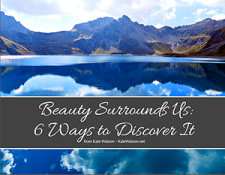
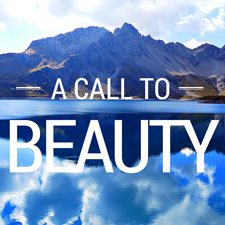
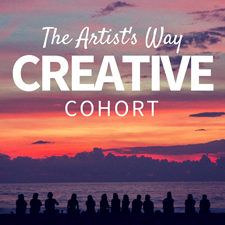
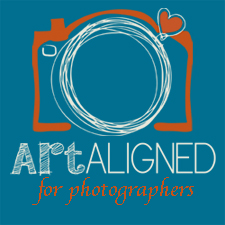






40 Things to Do Before 40 » KateWatson.net - […] my watercolor paintings (Done! Group show, August 1-30, […]